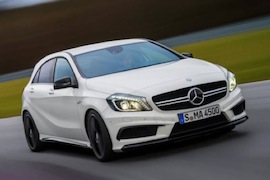MERCEDES BENZ A-Klasse AMG Models/Series Timeline, Specifications & Photos
First production year: 2013
Engines: Gasoline
Body style: Hatchback
Mercedes-Benz introduced the third generation of the A-Class in 2011 but waited two years before launching the most powerful version of it, the A45 AMG.
After two unconvincing generations of the A-Class, the German automaker considered that it was time for a completely new approach to that lineup. So, while those two models were based on a minivan shape, the third iteration of this nameplate was a five-door hatchback. But entering this new segment, dominated by the famous Volkswagen Golf, was not easy. Moreover, in the premium compact hatchback segment, the Audi A3 scored big, and its flagship version, the S3, had no competitor. As a result, Mercedes-Benz asked for some help from its AMG department, and the result was the A35 AMG and the mighty A45 AMG. The latter was the one that mattered the most.
Unlike the regular A-Class, which was not exactly a looker, the A45 showed a fierce front fascia. Its A-shaped lower air intake from the bumper, the splitter, and the side intakes meant business. Moreover, the main grille adorned by the twin-blade horizontal slat, specific for AMG versions, suggested that it’s a fast car. From its profile, a trained eye would have noticed the red calipers for the brakes and the large 18” light-alloy wheels, while at the back, the roof spoiler and the rectangular exhausts that peaked through the diffuser confirmed that there was something special about this hatchback. In addition, the C-shaped LED signature lights inside the taillights fitted as standard were not the same as those installed on the regular A-Class.
Inside, customers could feel why they paid a steep price for a hatchback. The A45 AMG featured high-bolstered seats with an option for sports ones with integrated headrests. Furthermore, the cabin featured enough carbon fiber trims to create a boy-racer dream interior. Moreover, the leather upholstery and Alcantara elements added a touch of luxury to the compact hatchback in a way that other automakers couldn’t. The driver fronted a flat-bottom steering wheel fitted with paddle shifters that controlled the gearbox. Inside the instrument cluster, the automaker installed two large dials with white background and red lettering for the speedometer and tachometer that flanked a TFT display that showed information provided by the car’s onboard computer. For the rear-seated passengers, the automaker used the same bench seat as in the regular A-Class but with better upholstery and the same contrast-stitching as on the rest of the vehicle.
When Mercedes-Benz introduced the A45, it surprised anyone with the most powerful two-liter engine available on a production vehicle. In the past, only Mitsubishi managed to provide such a punchy powerplant on a limited production vehicle and in selected countries. But nobody expected the three-pointed star brand to create a vehicle that could keep pace with serious sports cars. In addition, the A45 AMG was a daily driver that could do school runs and weekly shopping with the same ease as doing donuts in a parking lot.
